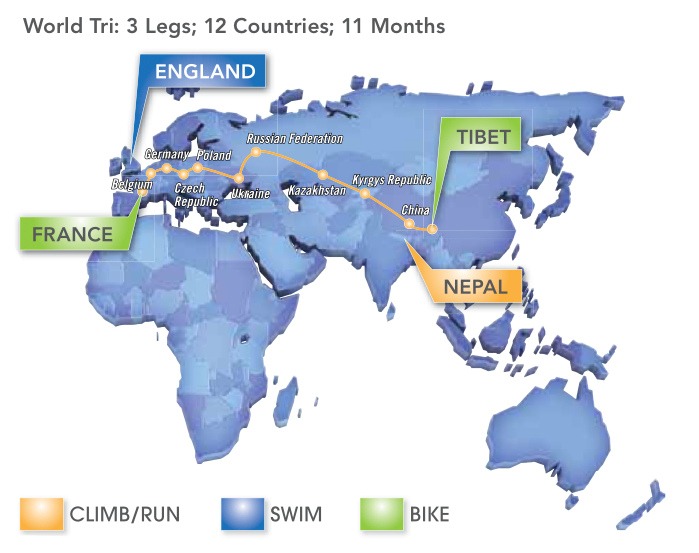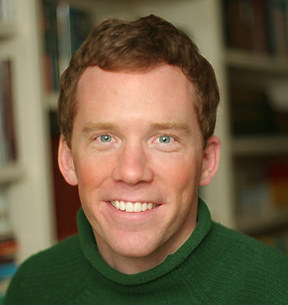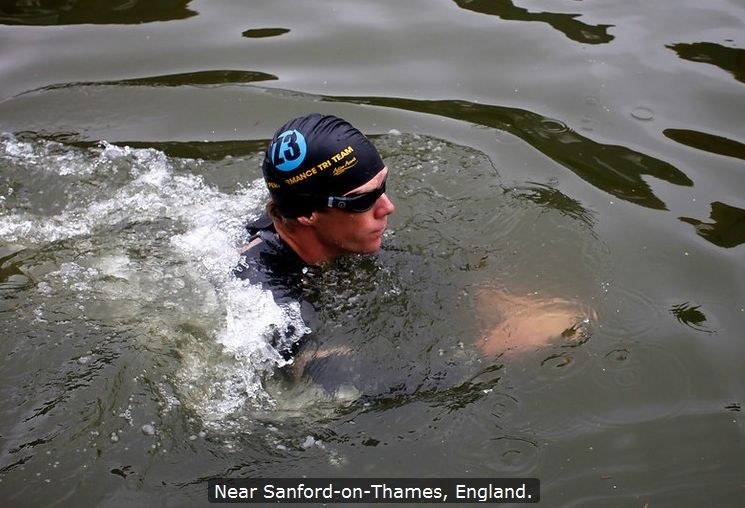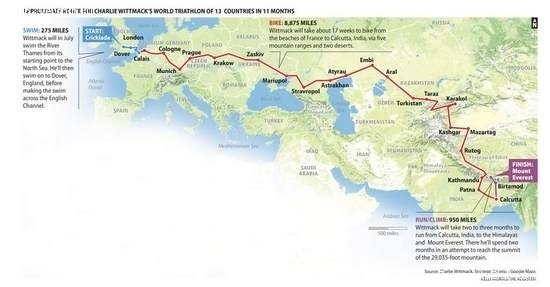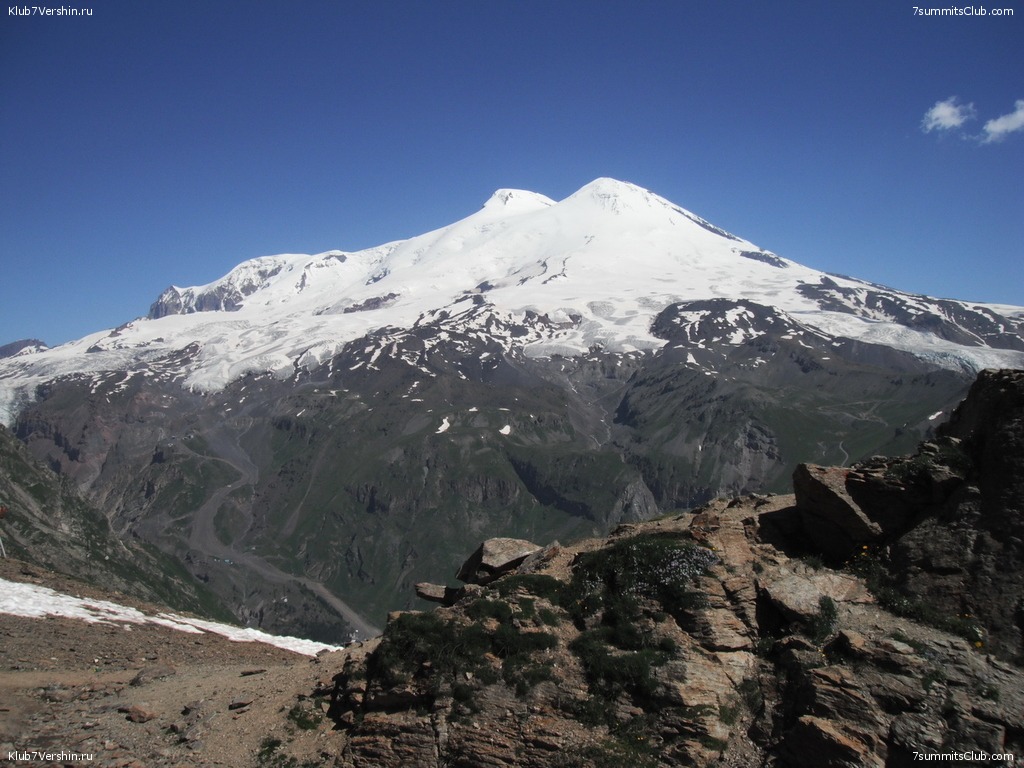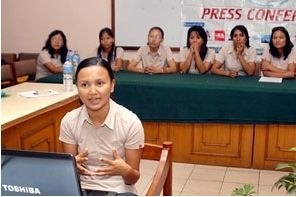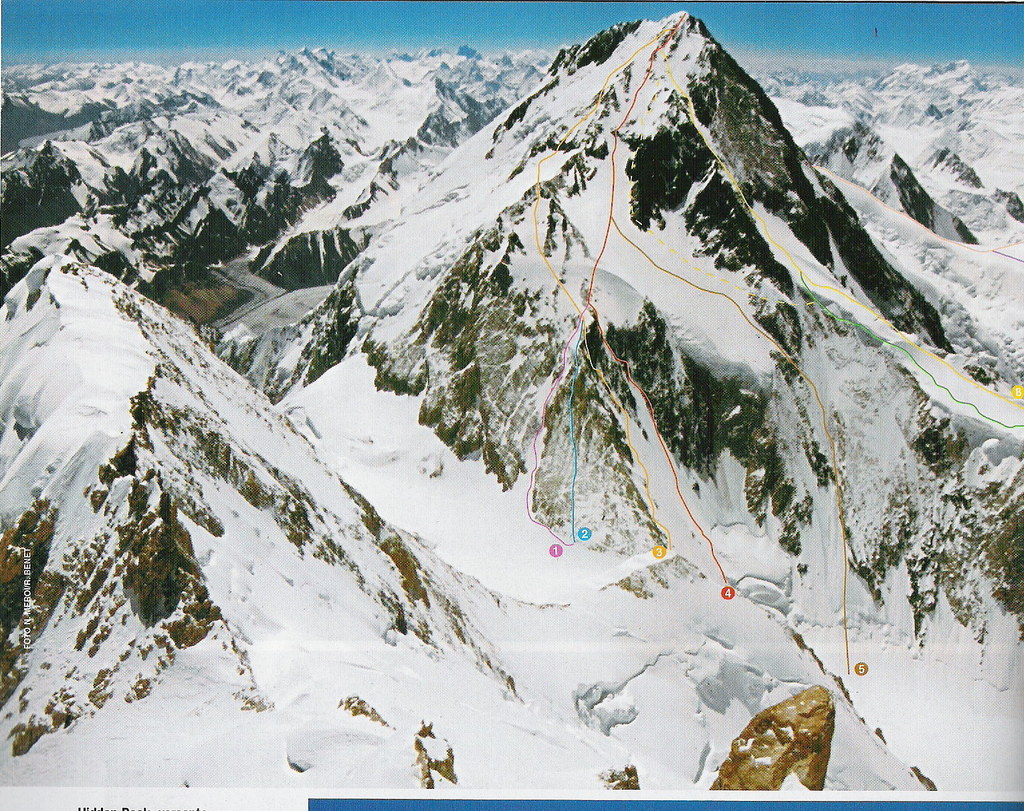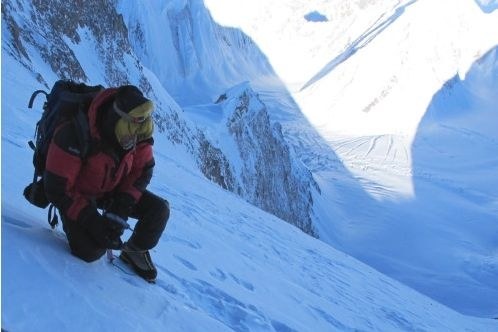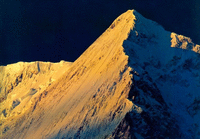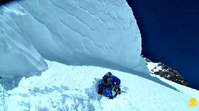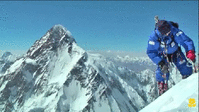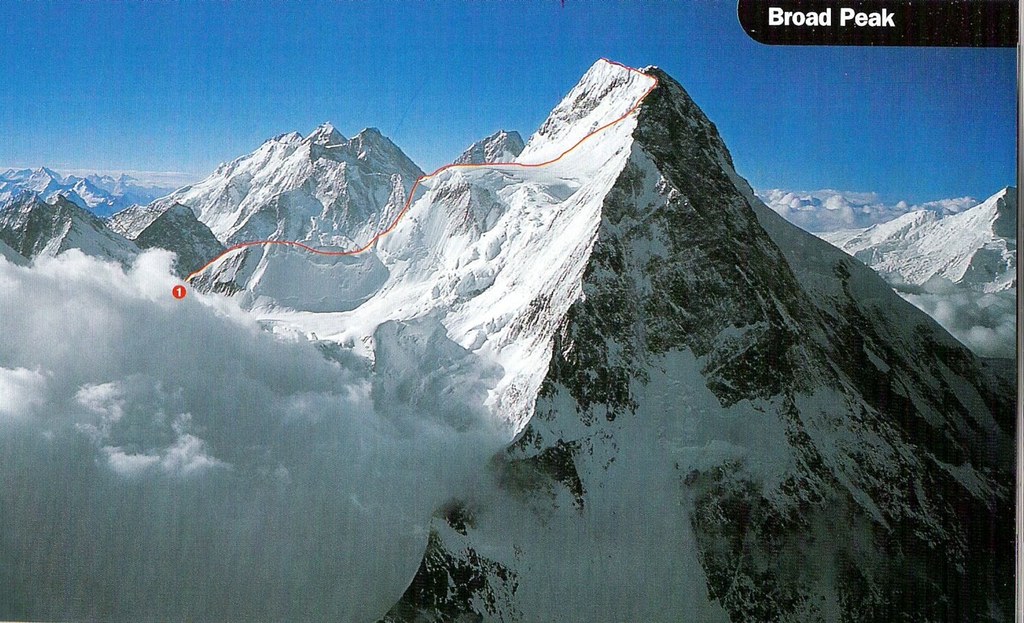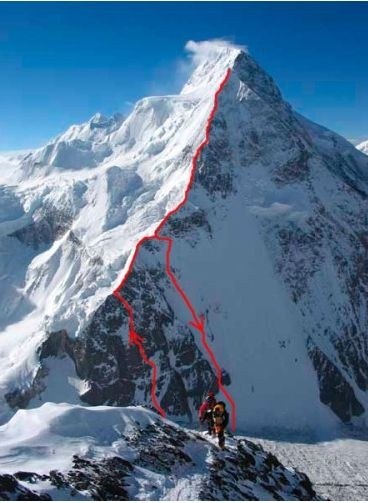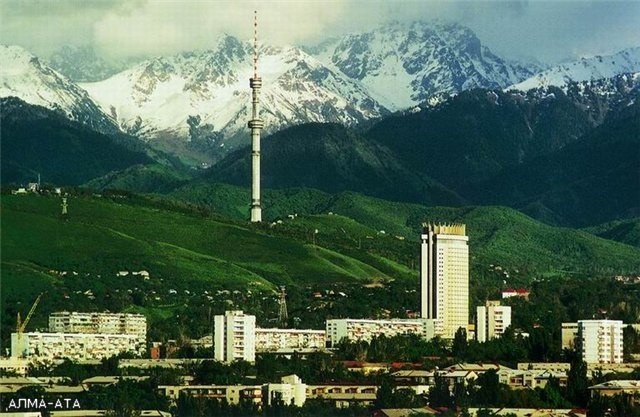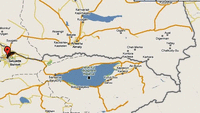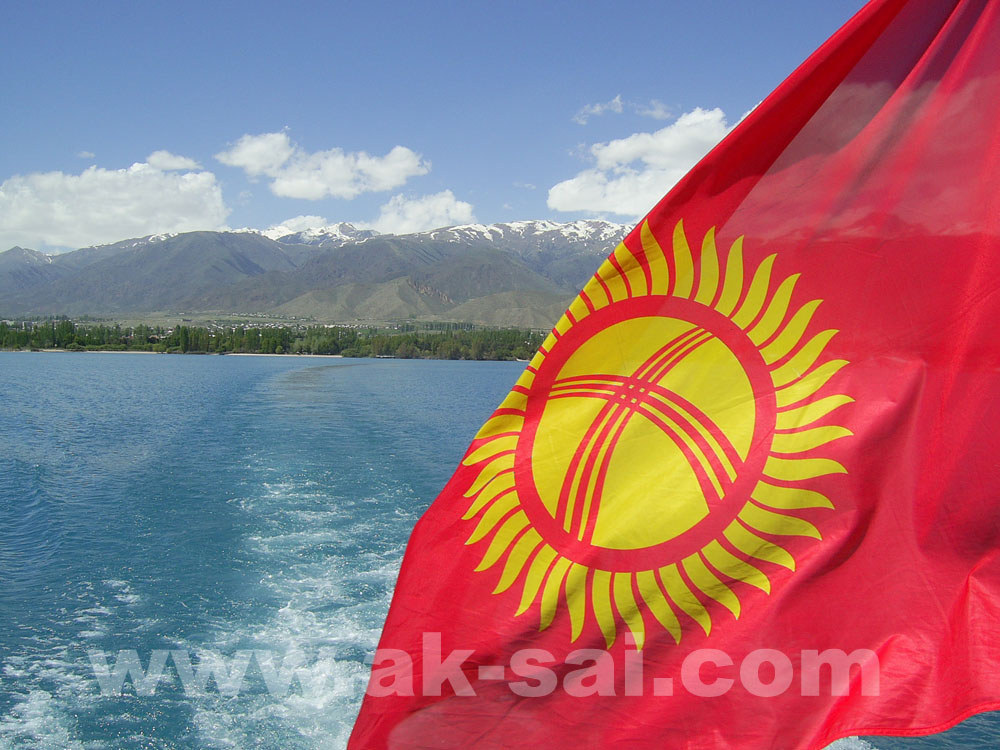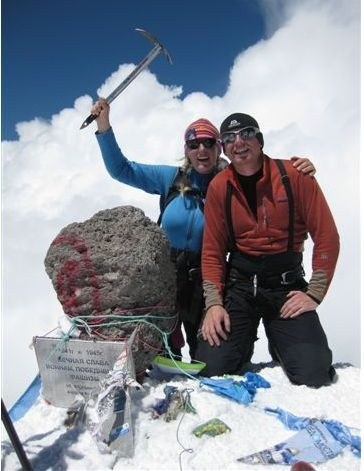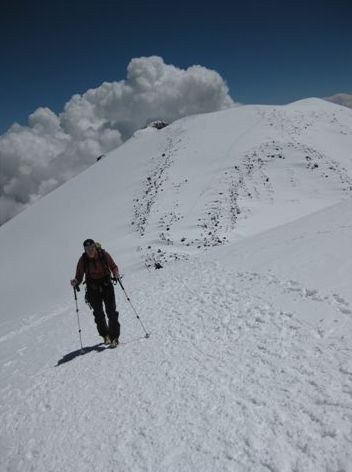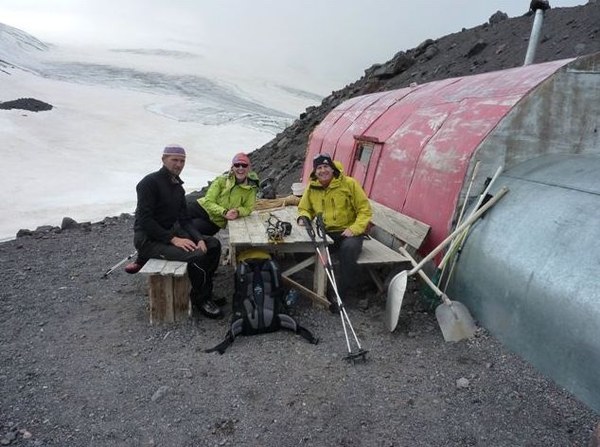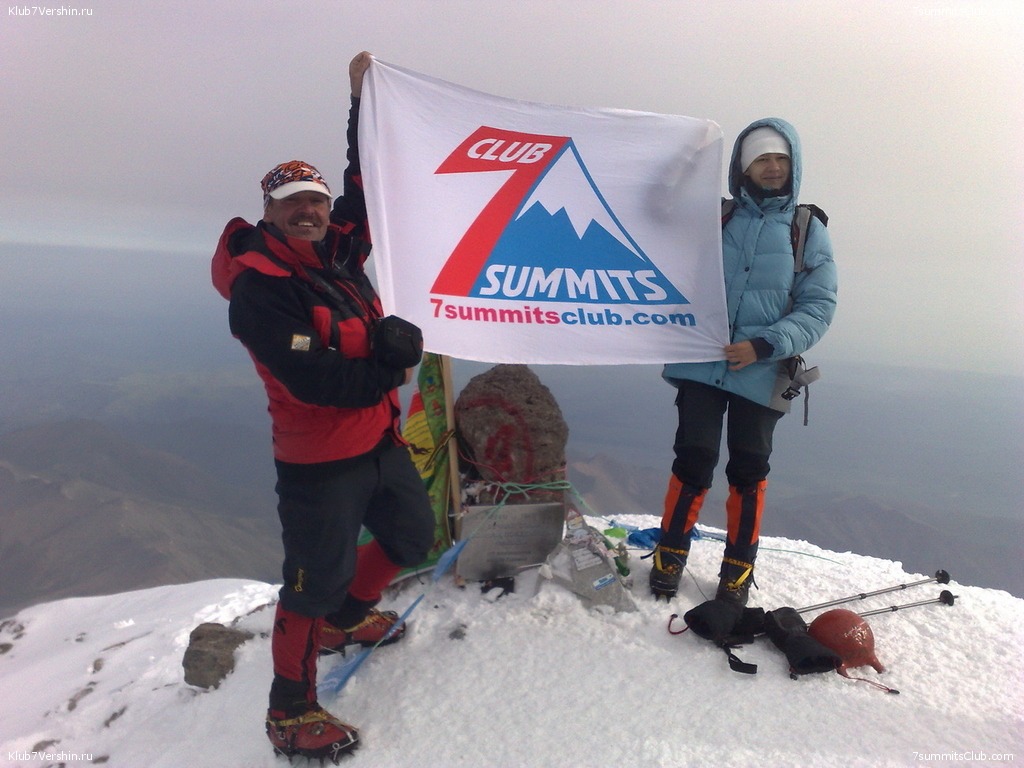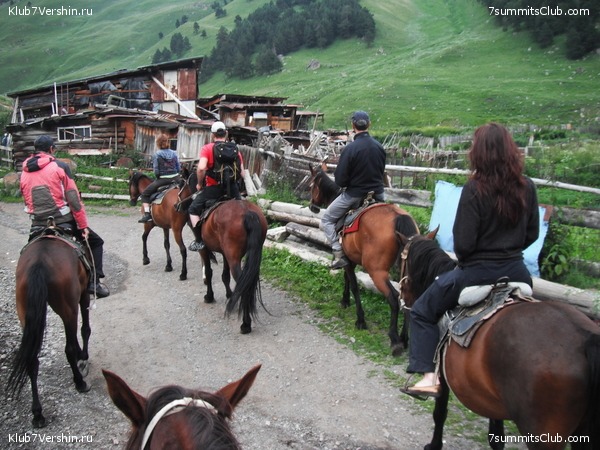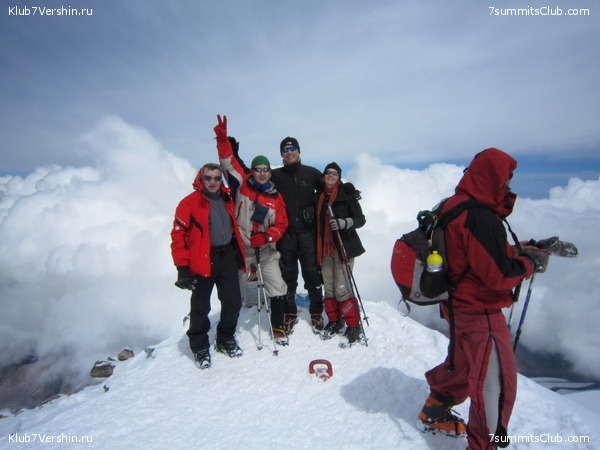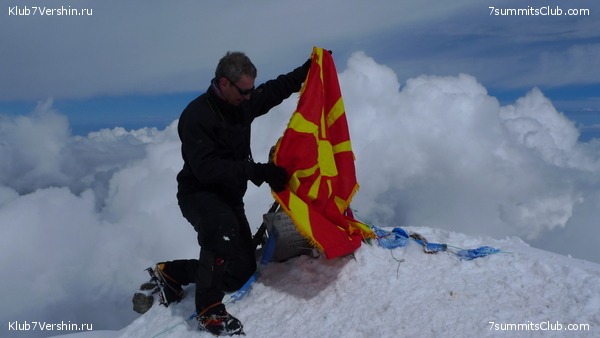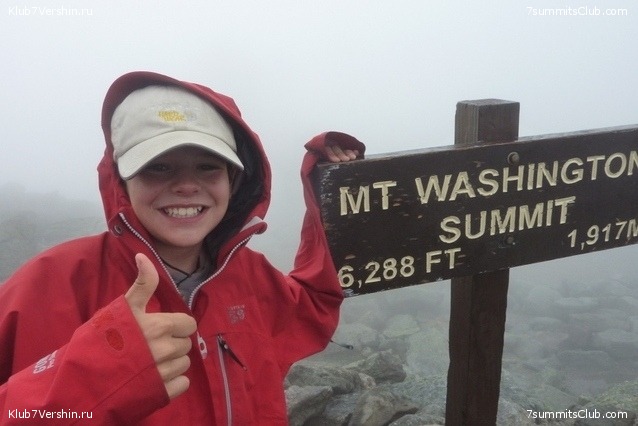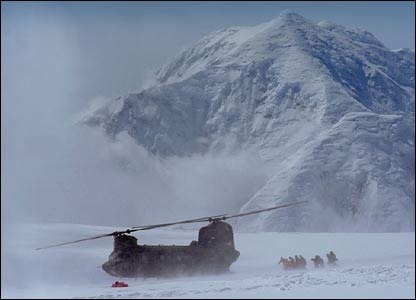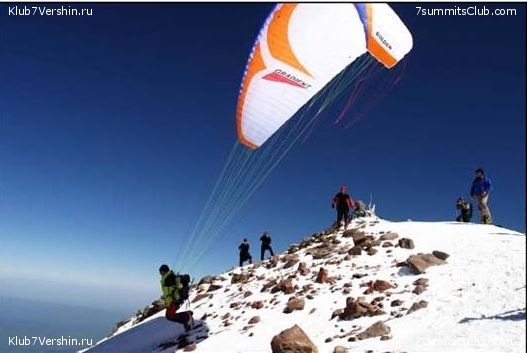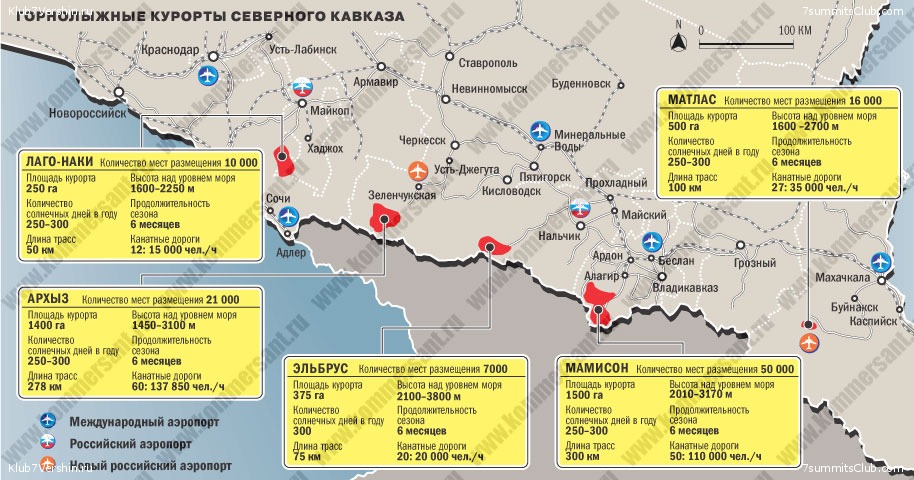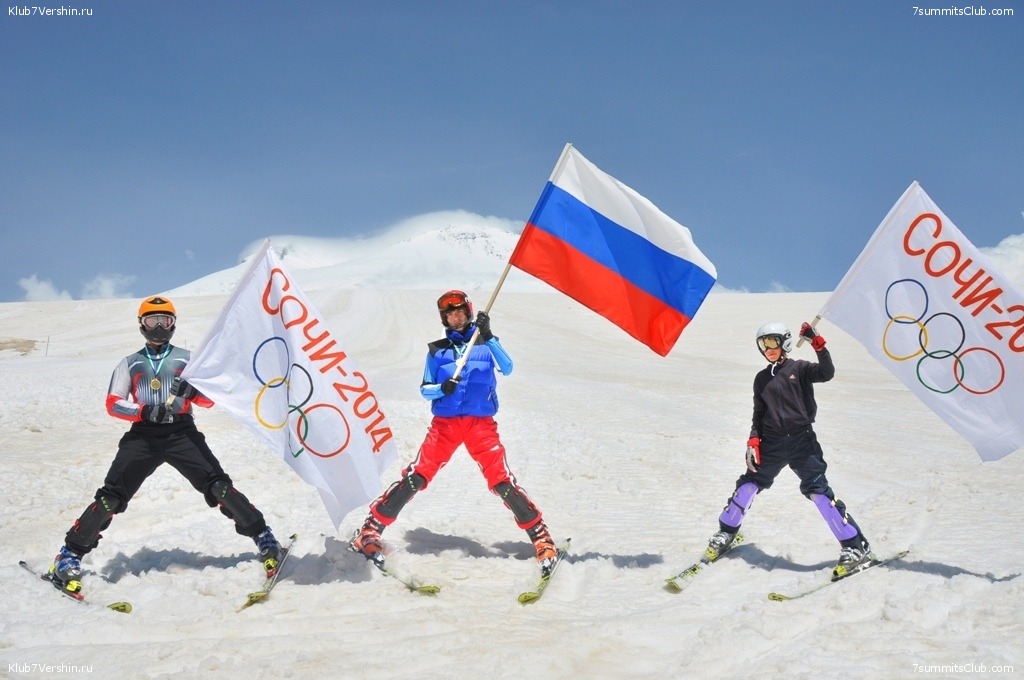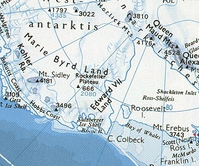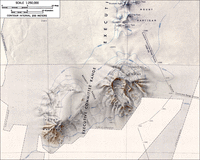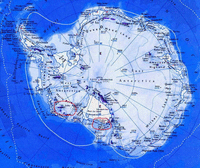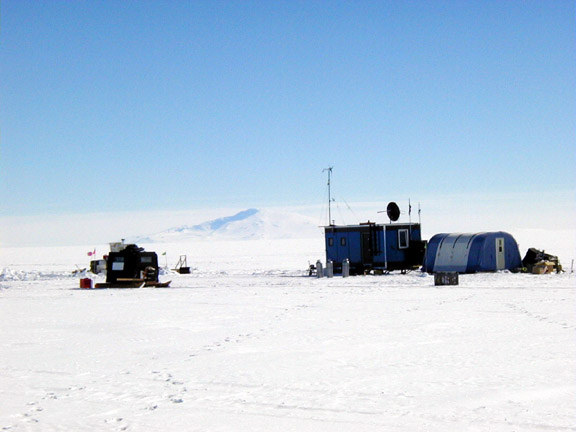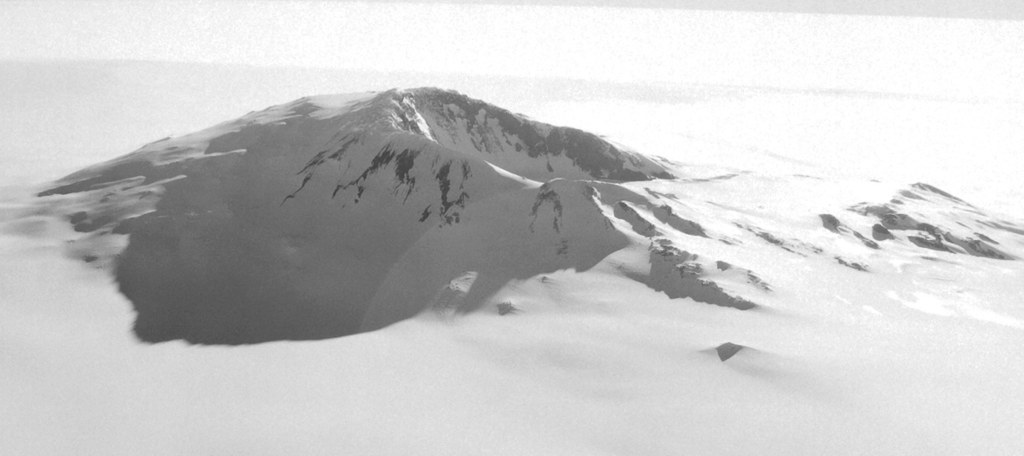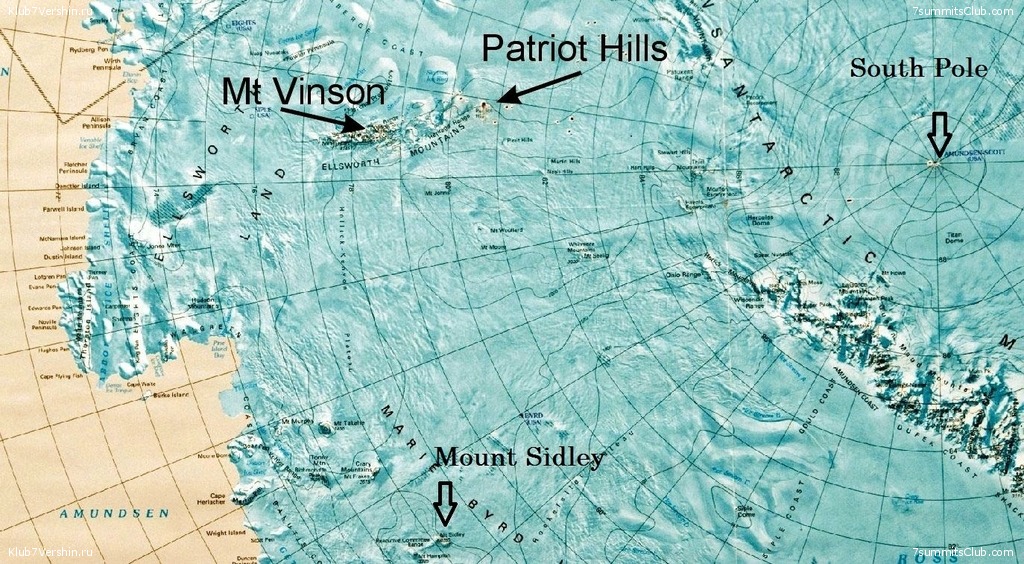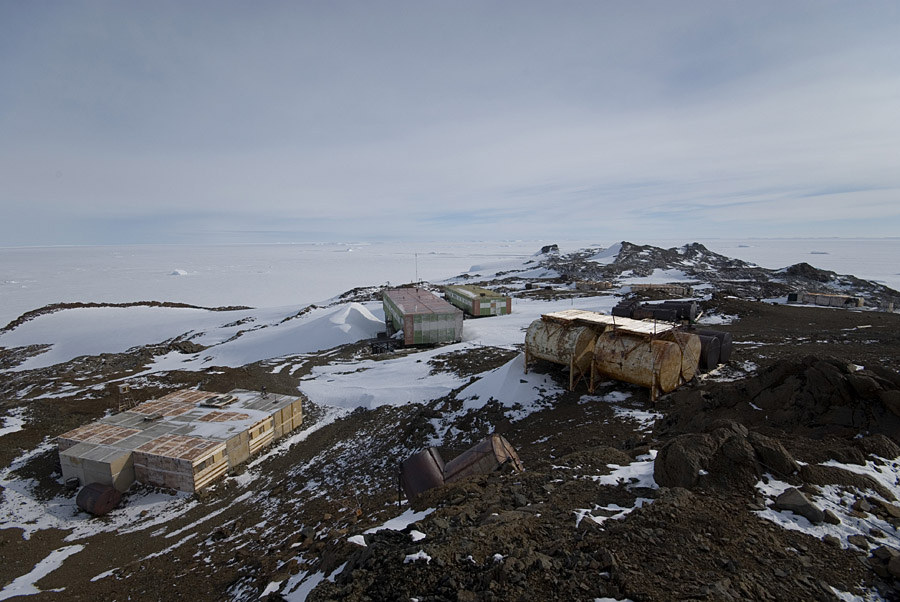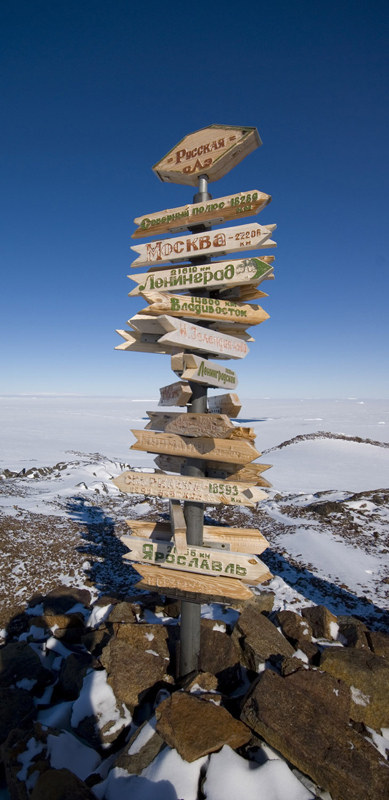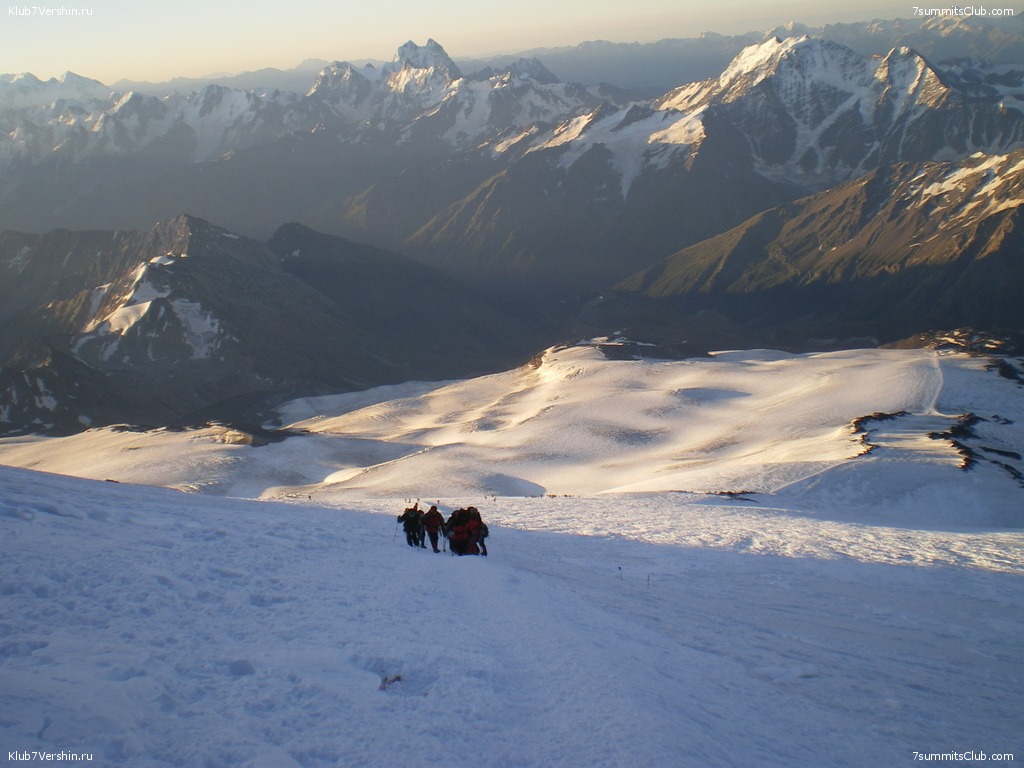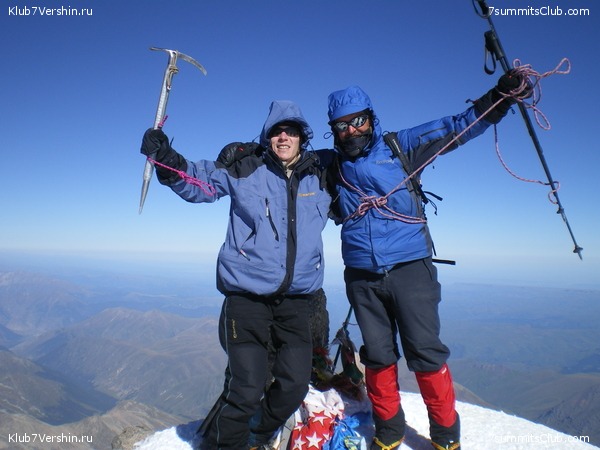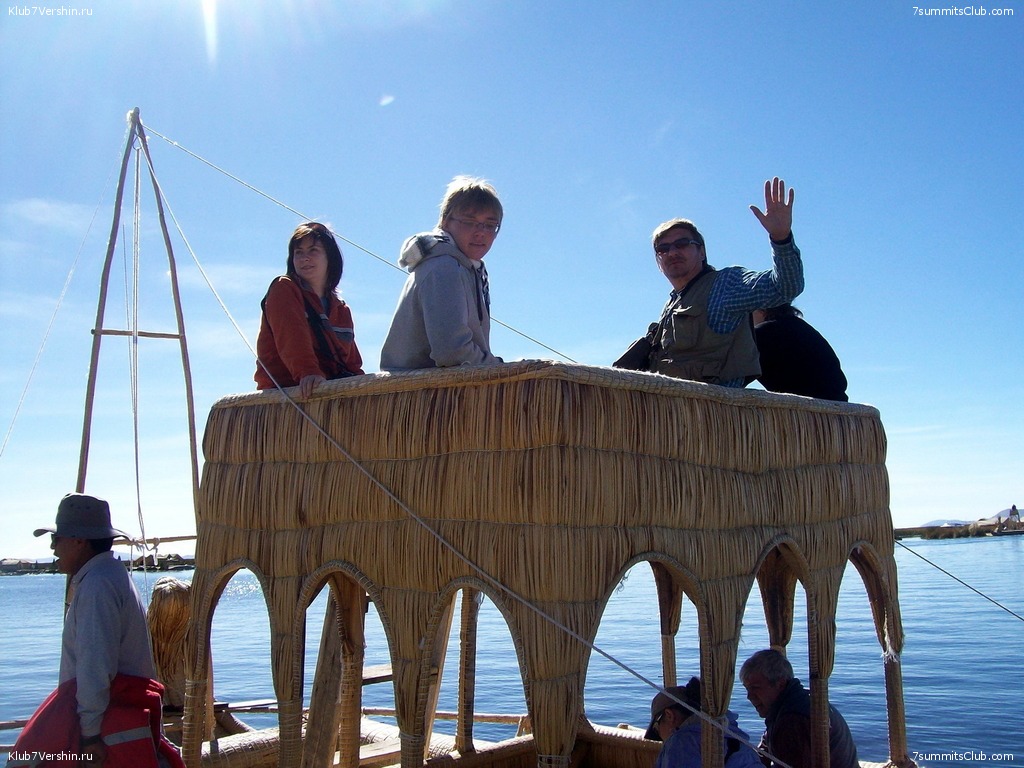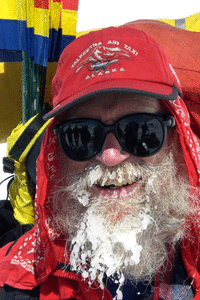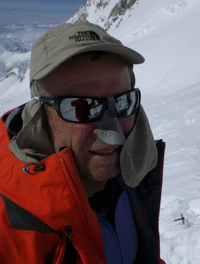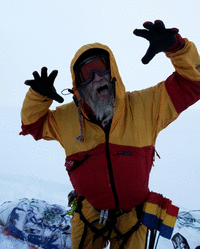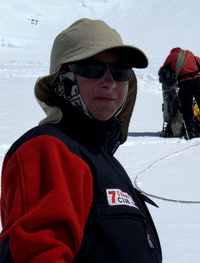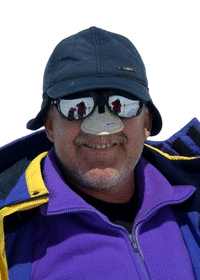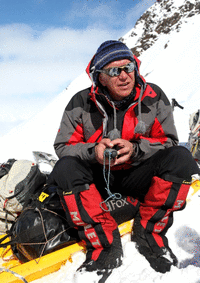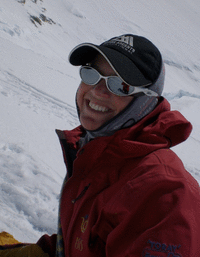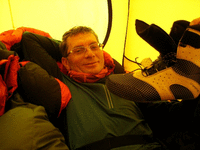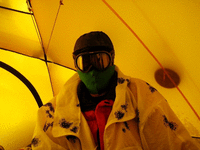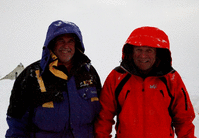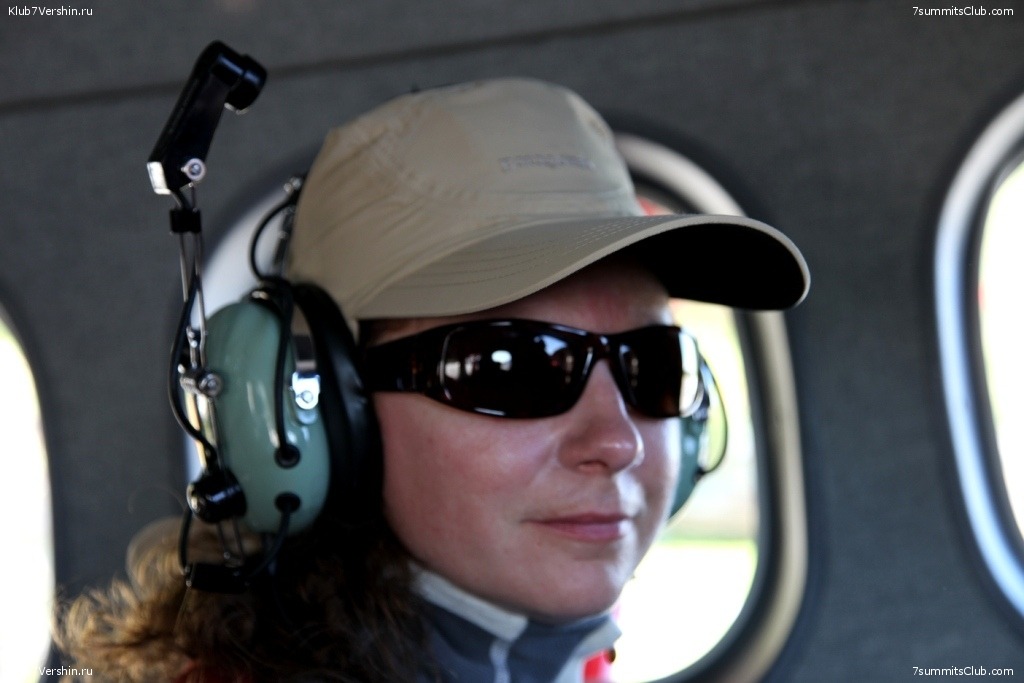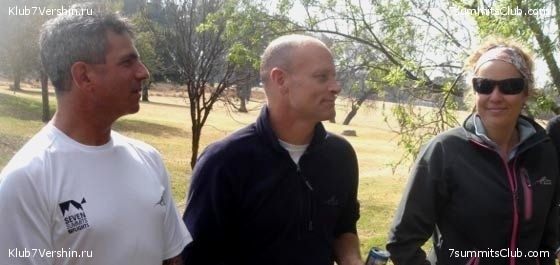All news: July 2010
American Charlie Wittmack attempts ultimate triathlon
Charlie Wittmack plans a new slant on climbing Everest, by completing a triathlon that is being publicized as the possibly the toughest human endurance event yet conceived. The 33-year-old practising lawyer from Iowa, who is also involved ...
Charlie Wittmack plans a new slant on climbing Everest, by completing a triathlon that is being publicized as the possibly the toughest human endurance event yet conceived.
The 33-year-old practising lawyer from Iowa, who is also involved with the Department of Global Health at Des Moines University, starts in the UK with a 275-mile swim down the Thames to the sea and then across the English Channel to France.
From there he is planning to cycle 9,000 miles across Europe and Asia to reach the Bay of Bengal, his projected route taking in Ukraine, Russia, Kazakhstan, Kyrghyzstan and China.
He will then run c950 miles from sea level up to the Nepalese Himalaya, where he hopes to finish his odyssey on the summit of Everest.
Wittmack’s journey through 12 countries is planned to take 11 months, and is, inevitably, being documented by a film crew.
This is no hair-brained project from an inexperienced adventurer. For a start, Wittmack has already climbed Everest. In 2003 he reached the summit with a Sherpa companion in arduous conditions on their third attempt. His success on the world's highest peak came after seven years of ascents on well-known major summits around the globe.
He's also trekked across East Africa, sailed the Indian Ocean in a handmade boat, and made a c5,000-mile cycle ride across the United States.
The English Channel remains his bête noire. In early 2008 he was placed first in the 32nd Annual Swim around Key West, a notoriously difficult marathon ocean race. However, during August that year, 15 miles into his attempt on the Channel, he was pulled out hypothermic and unconscious.
The World Tri, as the project is billed, is also attempting to raise money for education and global health. But not for the Triathlon itself, which is being totally financed by Wittmack and his wife Cate, who is a writer focused on maternal health and childhood education.
Keeping to schedule is important. It's difficult to get permission to swim the Channel and his pre-booked launch date is the 2nd August.
Wittmack also needs to reach China's border with Kyrghyzstan by the end of October, in order to allow enough time to cross the Tibetan Plateau to India before winter sets in.
But if all goes to plan he should be at Everest Base Camp before May 2011, in order to make an attempt on the summit.
Already, Wittmack has had to deal with a minor setback. Eight days into his swim down the Thames, he inadvertently took a small sip of water, spent that night being violently ill, and ended up having his first experience of the National Health System in a Maidenhead hospital.
He recovered swiftly and is currently around half way through the swim.
By Lindsay Griffin
15 climbers from 7 Summits Club on the top of Europe....
Elbrus.
Today, 29 July a large group of climbers 7 Summits Club climbed the Western Summit of Mount Elbrus. It included 11 members and 4 guide. 8 from them, led by Alexander Abramov, began their descent to the north, the ...
Today, 29 July a large group of climbers 7 Summits Club climbed the Western Summit of Mount Elbrus. It included 11 members and 4 guide. 8 from them, led by Alexander Abramov, began their descent to the north, the area of Emmanuel Glade. Some of them climbed the Eastern Summit by the way. Other climbers have successfully gone down to the refuge Barrels. The Weather was favorable for ascent.
Nepal women climbers to focus on Mt Elbrus
Shailee Basnet co-coordinator of the Everest Women Seven Summits Eco-Action speaks in a press meet in Kathmandu on Wednesday, July 28, 2010. The team successfully climbed the tallest mountain in Australia, Mt Kosciuszko/Targangil and after ...
Shailee Basnet co-coordinator of the Everest Women Seven Summits Eco-Action speaks in a press meet in Kathmandu on Wednesday, July 28, 2010. The team successfully climbed the tallest mountain in Australia, Mt Kosciuszko/Targangil and after a great start in Australia, the team is now gearing up to climb the tallest peak in Europe which is Mt Elbrus (5642m) in Russia starting on 23rd August 2010. Everest Women Seven Summits Eco-Action is a group of women mountaineers from Nepal aiming to summit all seven of the highest peaks in each of the seven continents.
KATHMANDU: The Everest Women Seven Summits Eco–Action (EWSSE-A), a Nepali team of nine women organised a press meet at Nepal Tourism Board Office on Wednesday to brief the media about their successful mountain climbing attempt in Australia. They successfully climbed the highest peak Mt Kosciuszko/Targangil (2228 metres) in the Australian continent. They had left for Austrialia on June 28.
Shailee Basnet co-coordinator of the Everest Women Seven Summits Eco-Action made a presentation on their successful mount climbing story.
The team who had successfully climbed the mountain includes nine members from various professions. The mountaineers are Asha Kumari Singh, Chunu Shrestha, Maya Gurung, Ngabhang Phuti Sherpa, Nimdoma Sherpa, Pema Diki Sherpa, Pujan Acharya, Shailee Basnet and Usha Bista.
The Australian part of the project was supported by the Government of Nepal, Nepal Mountaineering Association, Nepal Airlines Corporation, The North Face, The Crossing Land Education Trust(Australia), Outdoor Education Group(Australia), and the ‘Be Vegan, Go Green-Save the Planet’ campaign, Supreme Master TV, ICIMOD, Non-Residential Nepalis, Nari Nikunja and Nepal Tourism Board. The bid to scale Mt Kosciuszko in Australia coincided with the golden jubilee anniversary of diplomatic relations between Nepal and Australia.
The team is scheduled to climb the tallest peak in Europe Mt Elbrus (5642m) in Russia starting on 23rd August 2010.
If they succeed in their mission to climb the highest peaks in each of the seven continents, they will become the first all-women team to achieve the feat. In 2008, they became the first all-women team to scale Mt Everest.
By RAJESH GURUNG
The 7 Summits Club proud to inform that we will organize climbing program for Elbrus for Women Seven Summits Eco–Action....
Hidden Peak - 8th eight-thousander of Alexei Bolotov
ExplorersWeb: “American Marty Schmidt, Canadian Don Bowie, Russian Alexei Bolotov and Czechs Radek Jaros and Libor Uher have checked in from the top of Hidden Peak. Their's may be the first GI summits this season since previous summit ...
ExplorersWeb: “American Marty Schmidt, Canadian Don Bowie, Russian Alexei Bolotov and Czechs Radek Jaros and Libor Uher have checked in from the top of Hidden Peak. Their's may be the first GI summits this season since previous summit claims last week were left unconfirmed or denied by the climbers themselves”.
Don Bowie site (www.calpinist.com):
“Don called at 7:45 am (July 28) PKT to announce that he and Alexey along with Czech climbers Radek Jaros and Libor Uher and American climber Marty Schmidt have summited Gasherbrum I. Don reported that a storm was due to come in shortly, so they would not be long on the summit. He expected the return trip to base camp would be a long, arduous one due to inclement weather, deep, unstable snow, and tired climbers. However, at the moment, they were all elated to have accomplished their summit goal”.
It is possible that Alex and Don will continue the expedition. They will try to climb Gasherbrum - II. Gasherbrum I was for Alexei eighth eight-thousanders, plus he was first on Lhotse Middle. Bolotov was awarded by two Piolet d'Or (for Makalu and Jannu).
Site Alexei Bolotov, our friend and colleague: http://alexbolotov.ru
Picture of Don from the first attempt on G-I http://alexbolotov.ru
Khan-Tengri Expedition is in the base camp on the North Inylchek Glacier
Khan Tengri.
Group of climbers from the 7 Summits Club, arrived by helicopter to the base camp on the Glacier North Inylchek. Ludmila Korobeshko is a head and guide of expedition, that includes three participants – Alexander, Viktorov Sergey ...
Group of climbers from the 7 Summits Club, arrived by helicopter to the base camp on the Glacier North Inylchek. Ludmila Korobeshko is a head and guide of expedition, that includes three participants – Alexander, Viktorov Sergey Schekoldin, Andree Julin. First, they must draw up a timetable of acclimatization climbs. And for this you need to know the weather forecast. An English source of information about weather in the mountains www.mountain-forecast.com argues that our climbers in the next three days to go through heavy rain, and on Friday - is also quite heavy snow. Most likely, the first days of acclimatization will be held in tents with no exits in the alpine zone.
Iñurrategi repeats Broad Peak traverse, partly by new route
The Basque mountaineer Alberto Iñurrategi has just completed a committing traverse of all three Broad Peak summits, beginning with a new route to Broad Peak North. The complete traverse of the three Broad Peak summits, North ...
The Basque mountaineer Alberto Iñurrategi has just completed a committing traverse of all three Broad Peak summits, beginning with a new route to Broad Peak North.
The complete traverse of the three Broad Peak summits, North (7,550m), Central (8,011m) and Main (8,051m) had only been achieved twice previously.
In 1984 the legendary Polish mountaineers Jerzy Kukuczka and Wojiech Kurtyka, in alpine-style and with no previous attempt, climbed the difficult North West Ridge of Broad Peak North and continued over the Central to Main summit in four and a half days.
This was only the second time that both the North and Central summits had been climbed.
In 1995 the same route was taken by Japanese, Toru Hattori, Toshiyuki Kitamura and Masafumi Todaka, who also climbed in alpine style and completed the round trip from base camp in seven days. Todaka was actually on honeymoon with his wife, who remained at base during the ascent.
On the 9th July Alberto Iñurrategi, Juan Vallejo and Mikel Zabalza reached the summit of Broad Peak North after climbing a new line up the west-facing glaciated slopes leading directly to the 7,350m col between the North and Central summits.
The weather was very windy and they spent a rough night back at the col after a short ascent of the South Ridge of North Peak. Next day they were faced with the hardest section of the traverse, the ascent of the North Ridge of Central Peak.
Receiving a weather forecast that confirmed these strong winds would continue to prevail for the next two days, the three decided to return to base camp.
The Basque trio set out again on the 16th, regained the col on the 17th after a bivouac at c6,300m, and the same day Iñurrategi repeated their previous ascent of the South Ridge to the summit of Broad Peak North.
Next day they left at 3:00 am, expecting that it would take 11-12 hours to reach the summit of Broad Peak Central and descend to a bivouac on the 7,800m col before the Main Summit.
They were wrong. Although they climbed the first 400m of the ridge in two hours, it took another 10 to finish the remaining 300m, and then two more to negotiate the summit ridge.
Snow conditions were abysmal and at one point they took five hours to gain only 50m of elevation. All declared it was the worst snow they had ever experienced.
By the time they got to the 7,800m col, they had been on the go for 17 hours, were exhausted and, having travelled very light, were completely out of food. As it was nearly dark, they decided to descend to Camp 3 at 7,100m on the Normal Route.
After just seven hours rest, only Iñurrategi felt like getting up at 3:00 am and going for the Main Summit. It took him six hours, in an exhausted state and suffering from stomach pains, to reach the top. The saving grace was that he was able to follow the track opened by other climbers on the Normal Route several days previously.
He regained camp in just over four hours. As testament to the outstanding ability of this climber at high altitude, his time was faster than most fresh and well-provisioned mountaineers would clock for this section when reaching the top via the Normal Route.
In 2002 Iñurrategi became the 10th man to complete all 14, 8,000m peaks, but only the fourth to do so without supplementary oxygen.
By Lindsay Griffin
News from our Central Asia expeditions
Khan Tengri.
Yesterday, on Sunday, a group of the 7 Summits Club arrived in Alma-Ata. On the same day we climbed to the top of Kok-Tobe (1130m), which is located directly on the edge of town. The expedition began - its goal is an ascent of Mount Khan ...
Yesterday, on Sunday, a group of the 7 Summits Club arrived in Alma-Ata. On the same day we climbed to the top of Kok-Tobe (1130m), which is located directly on the edge of town. The expedition began - its goal is an ascent of Mount Khan Tengri. A Guide of group - Ludmila Korobeshko, members - Alexander Viktorov Sergey Schekoldin, Andrey Julin. Near the top of the Kok-Tube we photographed with the Beatles, which is there in the form of sculpture. Then we had lunch at a local restaurant.
We had breakfast on Monday already in the Kyrgyz capital Bishkek. A dinner was on the shore of beautiful lake Issyk-Kul. In the evening we hope to be in Karkara, the starting point from which shall be airlifted to the base camp on the glacier Northern Inylchek.
Maps: click to enlarge
Members of the 7 Summits Club are also on the way to other seventhousanders of the Central Asia. Also at the beginning of the route. Victor Sedov, arrived at the foot of Lenin Peak, successfully overcoming an obstacle, called the town of Osh. In his post, he inform hat now the situation is calm. Valery Miasoedov went to Tajikistan, to climb Korjenevskaya Peak. He is in Jirgital Village now, already the fourth day, in anticipation of a helicopter into a base camp at The Glade of Moskvina. Approximately 100 people from different countries are also waiting for a helicopter. The bad news is that all are in complete ignorance, and when that happens.
Di Gilbert, one of Scotland’s foremost female climbers achieved her goal – 7 Summits
Elbrus.
A Highland mountaineering instructor returned to Scotland last night after successfully climbing the last of the world’s Seven Summits. Di Gilbert is now one of just 276 people to have reached the highest point on each of the seven ...
A Highland mountaineering instructor returned to Scotland last night after successfully climbing the last of the world’s Seven Summits.
Di Gilbert is now one of just 276 people to have reached the highest point on each of the seven continents, after successfully climbing Mount Elbrus in Russia.
Last night, the 36-year-old climber said she was delighted with her accomplishment, which she described as a “bit of an ambition” among fellow mountaineers.
She said: “It’s been my unintentional aim to do this. There is no way I would have been able to do the summits if I had to pay for them, so I worked my way up them.
“I was an exhibition leader or guide during the Mount Kilimanjaro, Mount Vinson, Mount Everest, Carstensz Pyramid and Aconcagua climbs, helping others achieve their dream.”
Miss Gilbert added: “I completed the Denali climb in North America in a group of personal friends, and this last one with just my partner, Derek. As it was my seventh summit I didn’t want to work on it, I wanted a break with someone that was special to me.”
Miss Gilbert, of High Street, Grantown, who grew up at Alford in Aberdeenshire, admitted climbing the summits had been both physically and mentally challenging, but said it became a “little bit easier” to complete Elbrus knowing it was the last one.
She added: “All of the climbs were unique, and challenging in different ways – whether it be physically or logistically. Everest was perhaps the toughest as it is the largest, but they all had their own quirks.”
Miss Gilbert, who is a full-time mountaineering instructor, plans to spend time climbing in Scotland before deciding on her next far-off adventure.
By Shona Gossip
*************************
Seven summits. From http://www.digilbert.co.uk
"Mountaineers thrive on challenge: the desire to stand on top of the highest point on each of the seven continents has fired the imagination of climbing enthusiasts of all levels from around the globe.
Everest, Asia (8848m)
Aconcagua, South America (6960m)
McKinley, North America (6194m)
Kilimanjaro, Africa (5895m)
Elburs, Europe (5642m)
Vinson, Antarctica (4897m)
Carstensz Pyramid, Oceania (4884m)
Completion of this amazing feat, known as the Seven Summits, demands much of the climber - to travel to the remote and exotic corners of the world, scale the heights of mountain giants such as Everest and McKinley, and face extreme weather conditions and hostile environments for long periods over many years." Seven Summits, Steve Bell
On the 20th July 2010, Di Gilbert finally finished her unintential aim to climb all Seven Summits by standing on the top of Mount Elbrus.
It has never been on Di's agenda to climb the Seven Summits, purely due to the financial implications involved with such a large undertaking. However, she was aware that the only way she would be able to climb them, would be to work on them. And work on them, she did...
In 1999, she was Expedition Leader for World Challenge Expedition's Kilimanjaro Expedition, climbing the mountain via the Marangu route. She enjoyed it so much, she returned in 2001 as Expedtion Leader for Jagged Globe's Expedition via the Umbwe route.
In 2003, whilst working as a Guide for Antarctic Logistics and Expeditions, Nick Lewis and Di climbed Vinson via the normal route as every day work.
In 2004, she started working for Adventure Peaks as an Expedition Leader and successfully led their Cho Oyo (8002m) Expedition in Tibet. This provided the launch pad for Di to then lead their 2005 North Ridge Everest Expedition, where she was responsible for putting celebrity Jake Meyer on the summit on the 4th June.
In 2009, Di was joined by Derek Boggan and Catrin Thomas, where they flew into Denali National Park for an attempt on the Cassin Route. They had to settle for the West Buttress due to conditions on the mountain at the time.
Di was always realistic about the opportunity of leading an expedition to Carstenz Pyramid, but Adventure Peaks once again provided the opportunity and in 2009, Di and her 4 clients, successfully summited this elusive mountain.
Having now stood on 5 out of 7, Di made the conscious decision to try and finish the remaining peaks. She was Expedition for the Adventure Peak's Aconcagua Expedition in 2010, which left just one...
On 20th July 2010 at approx 1300, Di wept her way up the final slopes of Mount Elbrus after an 11 hour trail breaking ascent from Uncle Nick's Hut on the North Side of the Mountain.
Di climbed her 7th summit with her partner Derek and their Russian Guide Kirill Ivanov.
Photo's of the Expedition can be found here
http://www.digilbert.co.uk/gallery.asp?gallery_id=30#
and the report can be found here (I'm working on it now:))
Climbing Mount Elbrus in July, photos
Elbrus.
On our site, we published a gallery of photos, depicting an ascent of our guide Victor Bobok and his team on Elbrus. With his team, Victor went to the Western summit twice in one day. A few days later he went again himself, with his wife ...
On our site, we published a gallery of photos, depicting an ascent of our guide Victor Bobok and his team on Elbrus. With his team, Victor went to the Western summit twice in one day. A few days later he went again himself, with his wife Marina. Group members: Fred Cobey, Naim Logic, Alisa Schwarz (all - the U.S.), Ariana Leigh Myers (United Kingdom), Sashko Kedev (Macedonia), Dmitry Vladimirov and Dmitrii Kurkovich (Russia). Experienced guides Oleg Miller and Pavel Milanov also worked with this group ..
12-year-old Matt Moniz, dad break speed record for states' high points
Matt Moniz, 12, and his father, Mike, stand atop the 13,804-foot Gannett Peak, Wyoming's tallest mountain. The two recently climbed the highest points of all 50 states in 43 days. Though he's only 12 years old, Boulder alpinist Matt Moniz ...
Matt Moniz, 12, and his father, Mike, stand atop the 13,804-foot Gannett Peak, Wyoming's tallest mountain. The two recently climbed the highest points of all 50 states in 43 days. Though he's only 12 years old, Boulder alpinist Matt Moniz has climbed through plenty of steep rock, snow and ice on his way to the summits of a couple of 20,000-foot peaks. But on his most recent adventure, he had to watch out for cows, too.
While trying to climb to the highest point in each state in 50 days, Matt flew in a borrowed Cessna to a rough landing strip near the Illinois high point.
"We had to fly by the runway to make sure there were no cows" before landing, he said.
He and his father, Mike Moniz, rode bikes from there to the high point, Charles Mound.
The pair stood atop their 50th high point, Hawaii's Mauna Kea, on July 16, stopping the clock at 43 days, 3 hours, 51 minutes and 9 seconds. It appears to be a new speed record for high points -- which are generally self-reported to the Highpointers Club but not verified by them, according to highpointers.org.
The Monizes started the journey when they reached the summit of Alaska's Denali, the most difficult of the 50 high points. If they couldn't get up it in a timely fashion, the goal of 50 in 50 would be impossible.
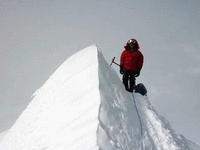 "It would be hard to put aside three weeks for Denali for the speed record," Matt said.
"It would be hard to put aside three weeks for Denali for the speed record," Matt said.
For Matt, the 50 in 50 goal was another adventure that helped raise awareness and money for Pulmonary Arterial Hypertension. Matt has taken up the cause because his best friend, Ian Hess, has PAH. Last summer, the Monizes climbed 14 Colorado fourteeners in eight days for the same purpose.
"After we did 14 fourteeners, we wanted to do something bigger to raise awareness," Matt said. "And not just in Colorado, in the whole United States."
Mike said this experience was different than the 14 fourteeners.
"With the 50 in 50, as much as anything, it was a cultural experience for us," he said. "We heard everything from local politics to environmental issues. It was great."
In addition to flying, Mike and Matt made a 12,000-mile loop by van -- nearly half the driving distance covered by the last group to attempt this, Mike said. Volunteers from the University of Colorado, Colorado State University, and Joel Gratz, a Boulder meteorologist who became the trip's weather man, drove them state-to-state, nearly around the clock.
In the northeast, they did six high points in one day. Mike said they often snoozed in between in the van.
Mike started climbing when he was a student at CU in the 1980s. Matt's enthusiasm for climbing -- sparked by a trek to Everest Base Camp -- has rekindled his, he said.
"Matt got me re-energized in mountaineering, in the alpinist world."
Matt also serves as an ambassador for Outdoor Nation, which focuses on getting kids outdoors. Mike said he likes for the family to include community service in their climbing.
Matt wasn't sure what they'll do next summer.
"We're thinking about next year taking a little bit of a break, slowing it down a little bit, maybe doing some individual rock and ice climbs," he said.
"Maybe not do any big expeditions for a while."
By Jenn Fields fields@coloradodaily.com
I want to climb Kilimanjaro before I die: Bill Clinton
Everest.
VIENNA (AFP) – At the age of 63, former US president says he has one more mountain to climb before he dies -- and that's Kilimanjaro, the highest peak in Africa. Clinton revealed the secret goal -- along with his dream of running a ...
VIENNA (AFP) – At the age of 63, former US president says he has one more mountain to climb before he dies -- and that's Kilimanjaro, the highest peak in Africa.
Clinton revealed the secret goal -- along with his dream of running a marathon -- while in reflective mood at the 18th International AIDS Conference, where he made the keynote speech on Monday.
He explained that one of his favourite movies was "The Bucket List," a 2007 film in which two terminally ill men, played by Morgan Freeman and Jack Nicholson, draw up a list of things they wish to do before they die, and then travel around the world to do just that.
"I'll soon be 64, so I think I'm old enough to join Jack and Morgan in making a bucket list, but I have an A list and a B list, and the B list would be fun to do but doesn't amount to a hill of beans whether I get to do it or not," said Clinton.
"I'd like to climb Kilimanjaro before the snows melt, I'd like to run a marathon before I give out, there's lots of things I'd like to do but it doesn't really matter whether I do them."
Clinton said his "A" list was far more important than his "B" list..
"What I'd really like to do if I could have my wishes, I would like to live to see my own grandchildren.
"And I'd like to live to know that all the grandchildren of the world will have the chance in the not too distant future to live their own dreams and not die before their time."
Located in northern Tanzania, Mount Kilimanjaro, 5,963 metres (19,563 feet) high, draws thousands of hikers a year to its long but relatively gentle slopes. Walkers stay in camps at several phases on the climb before ascending the final stage at night to enjoy the view of the African plains at dawn from the peak.
In 2009 a US study warned that the snows capping Kilimanjaro could vanish altogether in 20 years, most likely due to global warming.
A veteran campaigner who has attended every International AIDS Conference since 2002 -- this is the fifth since then -- Clinton quipped that he relished the ability to speak freely since leaving office, despite the downside of being an ex-president.
"That's the great thing about not being president anymore, I can say whatever I want," he said.
He then added to a swell of laughter from the audience: "Of course, nobody cares what I say anymore, but I can say it!"
South Africans flew off the top of Mount Elbrus
Elbrus.
The 'scariest thing' she's ever done … Champion paraglider Pierre Carter needed all his experience yesterday to fly safely off the top of Mount Elbrus in Russia with top climber and The Times photographer Marianne Schwankhart. The ...
The 'scariest thing' she's ever done …
Champion paraglider Pierre Carter needed all his experience yesterday to fly safely off the top of Mount Elbrus in Russia with top climber and The Times photographer Marianne Schwankhart.
The daring pair reached the summit of the 5642m Mount Elbrus at about noon and succeeded on their third attempt - after two crash landings - in flying tandem on a paraglider back to their high camp at about 4200m.
The South Africans aim to be the first team in the world to climb the highest peaks on each continent and fly off all the summits.
Carter, 43, who has competed internationally, said: "We had no wind and it was the hardest take-off I have ever done.
"But it was more scary for Marianne as she could see what was coming [the pilot flies at the back on a tandem flight]."
Schwankhart, 33, who has climbed dangerous and difficult rock walls from the Andes to the Karakorum, said this was the "wildest experience ever".
"We were okay but Pierre landed on me and the camera hit my nose.
"On the third attempt we had a slight, slight breeze. We ran and ran until the paraglider lifted me and then Pierre had to run for both of us. It was now or never, but it was the most scary take-off."
She said the weather was clear and still when they left for the summit at 4am, but it was a tough ascent and took about eight hours.
By CLAIRE KEETON
The Times Johannesburg
How safe to travel to Russia to climb Mount Elbrus?
Elbrus.
We are often asked about the situation in the Caucasus. Is it safe to travel to Russia to climb Mount Elbrus? We can say that it has not been a single criminal case in relation to foreign tourists. Even if they come on their own. Traveling ...
We are often asked about the situation in the Caucasus. Is it safe to travel to Russia to climb Mount Elbrus? We can say that it has not been a single criminal case in relation to foreign tourists. Even if they come on their own. Traveling with our company, you are in complete safety. Thousands of climbers successfully make ascent to Elbrus and return home happy. We believe that is only beginning of new era. The North Caucasus is in the center of attention of federal authorities.
A bit strange but typical peinture: two presidents of Russia love skiing
The North Caucasus is transformed into a huge construction site. To do this, our leaders created a special structure, a new federal district. Alexander Khloponin - one of the best managers of the country, was invited to lead this work. Already, the road to the northern slopes of Mount Elbrus started to build. There will be construction of a new resort. Each year the Mount Elbrus area is changing.
Big money, which will be brought to the area, forcing many local residents nervous. Everybody wants to be on the first film. Therefore, the struggle is between different groups and factions, a struggle which is often not visible, but its results are visible. It is not visible for tourists and climbers, fortunately.....
Five new ski-resorts on the map (red)
******************************
That's what the site says PlanetaSKI.eu
Forget The Tirol, the 3 Valleys or the Dolomites. In a few years it could be resorts in Karachayevo-Cherkessia or in Kabardino-Balkaria. The Winter Olympics in 2014 may just be the start of skiing in Russia.
Russia it seems has a huge untapped potential and the powers that be want to do something about it. The names don't quite run off the tongue in the same way as the popular resorts in the Alps but the mountains, snow and peaks are just waiting to be developed by the ski industry.
That is according to the Russians anyway.
5 new ski areas are being planned for the end of the decade in a $15b development. The resorts would be linked and available on one ski ticket. There would be 800 km of ski runs; bigger than many of the linked resorts in The Alps.
The Russian government is backing the move in a public-private partnership. Both President Medvedev and Prime Minister Putin are keen skiers.
Just the start perhaps
It's hoped a catalyst will be the 2014 Winter Olympics that will be held nearby in Sochi on the Black Sea.
According to reports in the Russian media international banks including JP Morgan Chase and Morgan Stanley are looking at getting involved.
The building and running of the 5 resorts would create 160,000 jobs.
The government is also hoping for a political benefit too as the mainly Muslim area has a high level of political instability and it is hoped new jobs and the economic benefits will ease tensions.
Over 1,000 people lost their lives in the area in the past 12 months in political violence.
The resorts will be constructed at Matlas, Dagestan; Mamison, North Ossetia; Arkhyz, Karachayevo-Cherkessia; Lago-Naki, Adygeya; and on Mount Elbrus in Kabardino-Balkaria.
Ambitious plans indeed.
Project 7 Volcanoes: Mount Sidley (Antarctica), the first climbing expedition
Sidley.
Program “Seven volcanoes”, it is climbing the highest volcanoes all continents over the world, Club Seven Summits organized in early 2011 the first mountaineering expedition to the highest volcano in Antarctica Mt. Sidley. Head ...
Program “Seven volcanoes”, it is climbing the highest volcanoes all continents over the world, Club Seven Summits organized in early 2011 the first mountaineering expedition to the highest volcano in Antarctica Mt. Sidley. Head of expedition - Alexander Abramov. Among confirmed participants: Dmitry Moskalev, Italian Mario Trimeri (who can become the first person climbed the seven volcanoes), Romanian climber Crina Popescu, which in December will celebrate 16 years (she also ends the program "Seven of the Volcanoes").
Mount Sidley is located in the mountain massive Executive Committee Range. This is chain of volcanic mountains in Antarctica, called the Marie Byrd Land. The thickness of the ice cover in this part of the continent achieves two kilometers. In the case of complete disappearance of the ice covered at this site will be an archipelago of volcanic islands such as Japan.
The height of the Mountain Sidley - 4,285 meters, the foot of the volcano has an altitude of about 2500 meters. Coordinates: 77 ° 02 'S 126 ° 06'z. E..
Mt. Sidley - a gigantic volcanic massif, a huge bulge dominates the uniform ice surface of the surrounding area. One side of the mountains form a huge caldera crater with a diameter of 5 km, its walls towering about one km altitude. And there may be found difficult climbing routes. On the other side there is only a gentle slope and the path to the summit can be maid on skis. However, the question with the highest point is still not fully clear. There may be several points in the ridge
We will have to check several points in the long summit ridge, with GPS, make sure a correct climbing line for next climbers. So we have to climb with the elements of a full exploration, as we have no high-quality report from first climbers.
American base in 2000 and Mt.Sidley
The mountain was discovered by Rear Admiral Richard E. Byrd on an airplane flight, November 18, 1934, and named by him for Mabelle E. Sidley, the daughter of William Horlick who was a contributor to the 1933–35 Byrd Antarctic Expedition. Despite its lofty status, the volcano languishes in obscurity due to its extremely remote location. It is little known even in the mountaineering world compared to the far more famous Mount Erebus, the second highest Antarctic volcano which is located near the U.S. and New Zealand bases on Ross Island. The first recorded ascent of Mount Sidley was by New Zealander Bill Atkinson on January 11, 1990, whilst working in support of a USAP scientific field party.
For the first time the foot of the volcano Seeley was reached by scholars of the American Antarctic Expedition ATV in the season 1958-59. The leader of expedition a Scottish glaciologist John Pirrin climbed up its slope nearly to the top, but to the highest point is not reached.
Under the program of studies US-ITASE American scientists visited the volcano area Seeley in 2000. Then they have a large collection of rocks and minerals, which enabled them to reconstruct the geological history of the volcano.
The route of our ascent involves a standard flight Punta Arenas - Patriot Hills on the big plane and then to the base camp on Mount Sidley on a small plane. What is the ascent to the summit, we can only guess. But we hope that our expedition will go down in history in many ways. And above all, accurately establishing the route, identifying the highest point of the ridge, taking pictures of all this and widespread throughout the world of information.
Russkaya station at Cape Berks on coast of Marie Byrd Land worked in ten years (1980-1990), it is only 300 km from Mt. Sidley.
The New York Times about Mt. Elbrus Climb
Elbrus.
To the Top of Europe By FREDRIK WESSLAU Published: July 16, 2010 “He doesn't do a lot of sports, does he?” asked Elena, our Russian mountain guide, pointing at me. It was not a very promising start for someone hoping to climb to ...
To the Top of Europe
By FREDRIK WESSLAU
Published: July 16, 2010
“He doesn't do a lot of sports, does he?” asked Elena, our Russian mountain guide, pointing at me. It was not a very promising start for someone hoping to climb to the peak of Mount Elbrus.
I had accepted a last-minute invitation to join three other amateurs set on climbing the mountain. The thought of conquering Europe’s highest peak was irresistible, even though the guide wasn’t far off the truth with her question.
While Elbrus is not considered a technically difficult climb, the elevation and unpredictable weather make it a challenge. At the peak, 5,642 meters up, air contains only about half the oxygen available at sea level. Normal functions such as walking can become extremely laborious.
After spending a few days acclimatizing ourselves, we settled into our base camp on Elbrus’s southern slope at 3,750 meters. The camp consisted of nine cylindrical huts made from an old Russian pipeline and painted in the colors of the Russian flag. The accommodation and food was basic, though this didn’t seem to bother the mice.
The view from the base camp made up for the no-frills lodging. The Caucasus Mountains stretched out before us to the south.
Elbrus stands just north of Russia’s border with Georgia, straddling the Russian federal republics of Kabardino-Balkaria and Karachay-Cherkessia. The inactive volcano dwarfs its neighbors. On clear days, you can see the Black Sea from the summit.
This part of the Caucasus has captured the imagination of Europeans for millennia. The ancient Greeks believed it was here that Zeus chained Prometheus to a mountainside and had an eagle eat at his liver as punishment for stealing fire and giving it to mankind.
Local folklore has it that Noah’s ark ran aground on Elbrus before eventually settling on Mount Ararat several hundred kilometers to the south. As it broke free from Elbrus, the ark’s keel split the mountain in two, creating its trademark twin peaks.
In more modern times, Elbrus has continued to mesmerize. In August 1942, as part of Operation Edelweiss aimed at taking Baku’s oil fields, a Nazi mountain division captured Elbrus and planted a Nazi flag on the summit. Six months later, a Soviet alpinist (who happened to be the father of one of our guides) climbed the mountain and tore down the flag as the Germans retreated.
During the Cold War, Elbrus was locked behind Iron Curtain. The mountain lost its place in the West’s consciousness as the highest mountain in Europe. Schoolchildren in the West were taught that this honor belonged to Mont Blanc in the French Alps, while travel guides, encyclopedias and newspapers affirmed this to the world. Denying that Elbrus was Europe’s highest peak became a way of denying that the Soviet Union was part of Europe.
The fall of the Berlin Wall and the expansion of the European Union has done much to align political Europe with geographic Europe. Today, only the Black Sea separates the Caucasus from the E.U. And Elbrus again enjoys the title of the highest peak in Europe.
All of this felt rather abstract at 3,750 meters. After a short night, we stepped out of our pipeline-huts at 3 a.m. The night was cold, and the thin air pierced my lungs. We set off under a star-coated sky to conquer Elbrus.
From 4,700 meters, we moved up the southern slope’s main route. As day broke, Elbrus’s twin peaks appeared before us, and the Caucasus mountains paraded their rugged contours behind us.
At 5,000 meters we turned left to traverse to the saddle between the two peaks. The sun was bright but the wind and altitude kept temperatures well below zero. My head was thumping and my heart was on overdrive. Every step felt like a small triumph. From the saddle, we walked diagonally up across a steep overhang, toward the Western summit.
Then, around noon, after nine hours of trudging through the snow with crampons strapped to our boots, we reached the summit plateau. From here it was a short walk to the summit — the undisputed highest point in Europe.
Fredrik Wesslau is a political adviser to the European Union’s special representative for the South Caucasus.
A successful ascent on Elbrus despite bad weather
Elbrus.
Weather forecasts for several days on Mount Elbrus shows a lack of visibility, strong winds and snowfall. No improvement. So we had to go today, not trying to wait for the mercy of the weather. Our experienced guides Victor Bobok, Pavel ...
Weather forecasts for several days on Mount Elbrus shows a lack of visibility, strong winds and snowfall. No improvement. So we had to go today, not trying to wait for the mercy of the weather. Our experienced guides Victor Bobok, Pavel Milanov and Oleg Miller decided to start this night.
They knew that it would not be easy and it turned out. The climb reminds winter ascents of Elbrus. The Group was ready for such situation. The two climbed on skis and went down. Victor Bobok twice went to the summit from the saddle to ensure 100% success of the team. All went on and all went down, albeit at different times. At an altitude below 4000 meters it was already warm, even in fog. More below – it was hot, climbers were tired, but there they were waiting for a shower, a restaurant, a clean bed in the Povorot hotel.
Congratulations to all!
News from our group in Peru, tomorrow - flight home
Yesterday, after a long trip to Peru, a group of 7 Summits Club came to Lima, the capital of Peru. In our active: boating on Lake Titicaca, overnight on the island Amantani on an Indian family, visiting the floating islands of reeds Totoro ...
Yesterday, after a long trip to Peru, a group of 7 Summits Club came to Lima, the capital of Peru. In our active: boating on Lake Titicaca, overnight on the island Amantani on an Indian family, visiting the floating islands of reeds Totoro and familiarity with the life of the local Indian Urus.
Then we moved to Arequipa, on road admiring the graceful vicuña - wild relatives of Lama. Arequipa - amazing colonial city of white stone. From the city you can see beautiful white tops of volcanoes - Misty 5825 m, 6075 m Chachani and Pichu Pichu 5500 m. And also, they say, quite near there is the highest volcano of Peru Coropuna 6425 m. It is not yet explored by us! There is something to aspire!
After Arequipa we fly over the famous Nazca lines, and visited the Ballestas Islands, full of fur seals, penguins Humboldt and various birds. It was the Pacific Ocean. So we have to travel from the Pacific coast up to altitudes of 4600 m pass of Salkantay and again descended to the ocean.
Today we have a tour of Lima and visit at Museum of gold the Inca gold. Tomorrow - flight home.
See you soon!
Luba. Guide and leader of the group
Second from Seven for Nepal Women Team
Elbrus.
We are waiting for them in Elbrus. Report: “ Our team climbed Mt Kosciuszko/Targangil on 7th July. It was a beautiful clear day. It was incredible experience to climb one of the world’s oldest mountains. Like they say in ...
We are waiting for them in Elbrus. Report: “ Our team climbed Mt Kosciuszko/Targangil on 7th July. It was a beautiful clear day. It was incredible experience to climb one of the world’s oldest mountains. Like they say in Australia, it may not be the tallest mountain in the world but it certainly makes you feel like on top of the world.
Outdoor Education Group from Moss Vale and Wilderness Sports made all the arrangements for the climb. Kosciuszko National Park helped with much information on the impact of climate change on the Snowy Montains. Ranger Rob Gibbs and Apline Scientist Ken Green accompanied the team on the summit along with friends from The Crossing Land Education Trust, Veg Climate Alliance and media.
We learnt from Ken that Australia has lost 30% of its snow in last 50 years. Mountain Pygmy Possum and alpine vegetation that used to get thick snow cover to hibernate underneath are now exposed to frost as there is not enough snow. As a result, certain species are threathened as cold is killing them”
Site: http://sevensummitswomen.org/
--
The team
The team members came together in 2007 to climb Mt Everest in 2008 spring. The expedition was called ‘First Inclusive Women Sagarmatha Expedition 2008 Spring’ (FIWSE).
Fastest climber to summit Everest Mr Pemba Dorje Sherpa brought forward the idea of organizing a Nepali women’s Everest expedition in order to increase their participation in mountaineering. Only seven Nepali women had reached the top of the world till 2007.
Mr DaGombu Sherpa and Ms Susmita Maskey joined the organizing committee. Nine women, who are now on a mission to climb the 7 summits, joined the team as climbing members.
FIWSE faced several challenges. It was not easy for the team to raise an enormous budget required for the expedition. Thanks to Nepal Government, United Nations World Food Programme, BP Koirala India-Nepal Foundation, United Nations Development Programme, MTV Exit, Swiss Agency for Development and Cooperation and many of our supporters, FIWSE was able to create history.
All women in the team made it to the summit and by May 25th, 2008, FIWSE became the most successful and largest women expedition to climb Everest. Also, first Nepali women from Brahmin, Gurung, Danwar and Chettri communities reached the top of the world.
The climbing members started a non-profit, non-government organization Global Inclusive Adventure Organiation (GIA) after the expedition. GIA focuses on environmental, empowerment and educational aspects of tourism sector.
The team traveled across sixteen districts of Nepal visiting schools and motivating students to climb their own mountains in a program called ‘Inclusive Sagarmatha Speakers’ , supported by United Nations World Food Programme. After the expedition, it was during the school program the team witnessed instances of climate change in various parts of Nepal. This encouraged the team to carry with them a message for climate action.
Everest Women 7 Summits Eco-Action, GIA’s brainchild was thus born.
Shailee Basnet (Coordinator) - A graduate of Business Information Systems and a Post Graduate of Journalism, she works as a reporter for Himalmedia. She became interested in climbing and mountaineering because of the physical and mental challenges it poses, which are quite different from her line of work. Lack of involvement in any kind of sports during her early years made her interested in challenging her limits as she grew up. At 25 years of age she reached a new height on May 24th 2008 by standing on top of Everest.
Asha Kumari Singh - A 24-year-old student, Asha comes from Danuwar community from Meghrail, Mahottari. She comes from a society where women are barely aware of their rights, are supposed to get married off sooner than later and dowry is rampant. Thanks to her grandmother who thought Asha was the ugliest girl among all five sisters and hence thought it was necessary to educate her, in case nobody wanted her marry her. Asha however was not worried about her looks but coming from the flatlands of Terai, was always curious about high mountains. She came to Kathmandu for higher education and got an opportunity to join the Female Outdoor Leadership training in the Annapurnas in the year 2004. Given her background she challenged conventions and impressed naysayers when she started climbing. She made not only her community but also the entire nation proud as she stood on top of Everest on 24th of May 2008.
Chunu Shrestha - Hailing from a poor Kathmandu family, Chunu began working to help support her family while she was just a sixth grader. Despite the financial hardships, she finished high school and started pursuing her education in Bachelors of Arts. When she heard about Susmita Maskey’s summit attempt in 2005, she became inspired by the possibility of succeeding in adventure tourism to support her family. With FIWSE she was able to nurture her passion for the outdoors that she dreamt about during her long days of work. At 27 years of age, she reached the Everest summit on the 25th of May 2008.
Nimdoma Sherpa - Still in high school, Nim is the youngest woman to climb Everest. Despite her small stature, she is dauntless and a very good climber, who impressed everyone during the Basic Mountaineering Course. She had her own struggle on the personal front. Her father passed away while she was a tenth grader. Still she continued her education, subsequently becoming the first in her family to complete the School Leaving Certificate (SLC). She spent lonely childhood in Kathmandu away from her mother for education. She took care of household chores while other children played. But she knew her life was destined to be different than that of everyone else around her. When she learnt about First Inclusive Women Sagarmatha Expedition she knew this is what she was waiting for. At 17 years, she set foot on the top of the world on the 22nd of May 2008. She is ruling wall climbing national champion.
Pema Diki Sherpa - Pema Diki, 22, is one of the three girls born to a struggling couple who moved to Kathmandu from Dolakha with nothing but the clothes on their backs. Two years before joining the expedition, a chance to trek in Gosainkunda enchanted this acupuncture assistant. Basic Mountaineering Course presented her more challenges which left her with desire for more climbing experience. She achieved what she had long dreamt for on 24th of May 2008 when she bowed her head to Cholmolungma, the mother goddess of the world. She has great faith in education and as a child dreamt of being a teacher. The team has been conducting educational interaction in different parts of the country, sharing the experience of struggles and lessons learnt during the expedition, motivating students to believe in their dreams. With this program her childhood dream became reality. She aspires to travel and learn more in life and share her knowledge and experiences with youth all over the world.
Pujan Acharya - Pujan worked as a human rights activist in Dolakha. From early on, despite growing in a society where women are supposed to stick to household chores, she had a passion for sports. In her village, she used to play with men for there wouldn’t be women players. An accomplished volleyball player and marathon runner, Pujan, 25, holds several awards for competition at the district Level. But that was not enough for someone who grew up at the foot of Rolwaling Himalayas. She gained her first mountaineering experience in 2003 when she completed Female Outdoor Leadership training. Finally she made it to the summit of Mt. Everest on 22nd of May 2008. She enjoyed a different taste of Everest and adventure as she skydived in the Everest region on 17th October, 2009 from 29,300 ft. During the cabinet meeting of Nepal Government held at Kalapatthar (5240 m), she actively participated as a venue manager.
Maya Gurung - Maya had a childhood marred with struggle and was an early rebel. She saw poor state of women both in her home and village. She always wanted to break free from it. Maya tried hands on various fields including bowling where she reigned as national champion for four years. But nothing really satisfied Maya before she went ahead to join Basic Mountaineering Course and then to climb Everest. This rebel at heart finally lived her dream of climbing on top of the world on 22nd of May 2008, and became the first Gurung woman summiteer at the age of 28. She lived her long cherished dream of sky diving on 10th October, 2008 with Everest in the backdrop. Maya led the Mt Manaslu clean-up expedition as coordinator and also was active venue manager for the cabinet meeting of Nepal Government held at Kalapatthar (5240 m) on 4th December, 2009. Her dream is to see women empowered and educated so that they are at least able to stand up for themselves.
Ngabhang Phuti Sherpa - Ngawang is from Taplejung district, home of Kanchenjunga. She lost her parents in an early age. She and her elder sister quit education to take odd jobs to look after younger siblings. She ran a restaurant in Kathmandu for couple years and quit it later after her sister went abroad. Several Sherpa climbers encouraged her to explore mountaineering. But she did not like the idea of climbing alone. When she learnt that a women’s team was being put together for climbing Everest, her hidden desire made her give it a shot. This 33-year-old woman felt she did the right thing when she joined Basic Mountaineering Course. On the 22nd of May 2008, she reached her highest destination, Mount Everest.
Usha Bist - Born as fifth daughter in the Far-Western district of Kailali, Usha was left in the jungle for dead. That’s what earned her nickname Bandevi- goddess of the forest. It was a fellow villager who saved the new-born. From early on, Usha was inspired by women climbers and wanted to climb Mt Everest herself. She came to Kathmandu to climb Everest, not knowing where to start. She completed basic and advanced mountaineering courses, climbed a number of peaks including the notorious Amadablam. In 2007, she earned spot in the Loktantrik Expedition Team, to attempt Everest. She was left behind at 8,400m and later rescued. To everybody’s surprise, this 24 year old finally stepped on the top of the world a year later. Her connection to forest is still alive as she is the president of Sasakta Mahila Samudayik Ban in her home district.
The group starts to return from Alaska
The expedition of 7 Summits Club at McKinley led by Maxim Bogatyriova began returning from distant Alaska. After descending from the summit and travel to Talkeetna, the group made several trips to the nearest surroundings, examined in ...
The expedition of 7 Summits Club at McKinley led by Maxim Bogatyriova began returning from distant Alaska. After descending from the summit and travel to Talkeetna, the group made several trips to the nearest surroundings, examined in detail all the sights of Anchorage. Everyone really wants to go home, so as far as possible, began to change flights, with dates of departure at an earlier date.
Portrait Gallery
Seven summits to fly from. Project of South African climbers
Elbrus.
A team of three intrepid athletes is preparing to climb the seven highest mountains on all seven continents, and then paraglide down, to raise funds for charity. THE paraglider slowly drifted down from the ...
A team of three intrepid athletes is preparing to climb the seven highest mountains on all seven continents, and then paraglide down, to raise funds for charity.
THE paraglider slowly drifted down from the blue sky, moving in broad circles as he lined up to land alongside a banner reading "Seven summits, 7 flights".
Pierre Carter paraglides in to the press briefing at Delta Park Pierre Carter's aim was perfect - he landed softy and gently ran up to the crowd gathered in Delta Park in northern Joburg, his rectangular orange and white parachute billowing behind him.
Carter is one of three athletes to tackle this "journey of a life time", in which they will be the first team in the world to summit the highest mountain on each of the seven continents, and once on the summits, paraglide down to their starting points. The other members of the team are 33-year-old Marianne Schwankhart and Peter Friedman. Carter and Friedman are both 43.
They will set off on Sunday, 11 July and begin by tackling Mount Elbrus in Russia, at 5 642 metres. The other summits on which they will be leaving their footprints are: Carstensz Pyramid in West Papua, Indonesia (4 884m), Mount Vinson in Antarctica (4 897m), Kilimanjaro in Tanzania (5 895m), Denali in Alaska (6 194m), Aconcagua in Argentina (6 959m), and the tallest of them all, Everest in Nepal (8 850m).
They admit that Carstensz Pyramid is the one that makes them the most nervous; despite the fact that it is the lowest, it is the most dangerous, and no one has ever tried to paraglide off it before.
"Walking back down a mountain is the most dangerous part of climbing, so paragliding down will reduce the risks," says Carter. All three members of the expedition recognise that there are great risks involved.
Problems for paragliders at these heights include strong winds and temperatures dropping to -30°C, or -50°C with the wind chill element. If the winds are too strong they will have to wait until they drop, for up to eight hours, if necessary.
The three have had special lightweight gliders made, weighing 10 kilograms. A standard glider weighs 40kgs.
Carter and Schwankhart will do a tandem paraglide off the summits, so that Schwankhart can photograph the summits on the way down, while Friedman will attempt the flights as a single glider. They will be taking along two cameramen, Guy Habbard and Kyle O'Donaghue, to capture the three of them climbing and flying. Both are climbers as well.
Everest
The idea originates with Carter, who has had this dream since 1991. The team expects to finish the challenge in around two years, largely driven by financial constraints and weather and seasons. For instance, Mount Everest can only be climbed between March and May.
The idea of climbing the seven summits originated with Dick Bass in 1985. Since then more than 200 people have climbed all seven. Climbing and paragliding off them has been attempted before, by a French couple, but they never completed the task.
Carter has been paragliding since 1988, and represented South Africa in the world paragliding championships for five consecutive years between 1991 and 1995. He has been climbing for almost 30 years and has summited and paraglided off two of the seven mountains - Elbrus and Aconcagua. He is considered to be one of the 15 greatest paragliders in the world, and will be the team leader of the expedition.
Mountaineer
Schwankhart, an award-winning photo journalist with The Times newspaper, has been a climber since 1995. She was the first woman to climb the sheer east face of the central tower of the Torres del Paine in Chile in 2003, and returned in 2008 and climbed all three of the peaks, again setting the record for a woman.
Paragliding off Mt Elbrus in Russia In 2005, she climbed the Trango Tower in Pakistan - 900m of vertical rock face - to a height of 6 500m. The same year she climbed Cerro Torre in Patagonia, Argentina. Climbing a sheer cliff face requires the climber to sleep for several nights on the mountain, sleeping in a suspended hammock-like contraption, hanging from the mountainside.
In 2006, she filmed No Need for Parking - an Africa Rock Adventure, a record of her climbs in southern Africa. Remarkably, Schwankhart doesn't see the climbing or the sub-zero temperatures as her greatest challenge in the venture; she wants to be able to take good photographs.
"The purpose of my trip is to take amazing photographs, so I hope I can do this. My main worry is whether my camera batteries are charged," she explains. The climbing is of secondary concern. "Mount Elbrus is an easy mountain, I am not too worried. I can rely on muscle memory for the climb."
She is not a paraglider though, and is a little concerned about being air sick.
Friedman has been paragliding for eight years and has fixed-wing and helicopter licences. He has a black belt in karate and has represented South Africa in Japan at the world karate championships. He has also represented South Africa in the world surf skiing championships in the United States.
He has been the driving force behind putting the expedition together, raising the all-important funding and sponsors.
Flight from Elbrus by Carter
Funds
The expedition will be raising funds for The Trust, an organisation that raises funds for 100 charities, with causes ranging from crime survivors, abused animals, HIV and Aids sufferers, to protecting the environment. This year's particular cause is fighting human trafficking, in partnership with Cintron Africa, says Tracey-Lee Cohen, the managing trustee.
The Trust will run a series of TV and radio adverts by R&B singer Akon to assist in raising awareness of human trafficking. "The anti-human trafficking case is just one example of a social cause that will benefit from the bravery and initiative shown by the 7 Summits 7 Flights team," says Cohen.
The expedition will also be raising funds for The Smile Foundation, a charity involved in assisting children with facial anomalies get surgery.
"We admire the dedicated work of charitable organisations such as The Smile Foundation and hope to help provide them with the resources and funds they need to do their work and overcome their own challenges," says Carter.
The three estimate they will need about R7-million to complete the whole venture. All the gear has been sponsored, but funding is still needed. Donations can be made through their website.
The team can be followed on a range of social media: they will be updating their website, Twitter and Facebook pages every few days, and articles will appear in The Times newspaper. DSTV will provide R2-million in airtime to the expedition.
Read more: http://www.joburg.org.za/content/view/5430/266/#ixzz0tBukqMMj
*********************************************************************
THE MISSION
7 Summits 7 Flights is an initiative pioneered by Pierre Carter, Marianne Schwankhart and Peter Friedmann with the aim of raising funds for Smile Foundation and The Trust, an umbrella charity providing a safe and transparent conduit to various charities, by climbing to the summits of the highest mountains of each of the seven continents and paraglide from their summits. All contributions will benefit both charities as well as the Seven Summit Seven Flights project.
The notion of climbing the seven summits was first conceptualized by Dick Bass, an American businessman and amateur climber, who completed all seven summits in 1985. Since then, more than 200 climbers have completed the challenge, with the youngest being eighteen year-old Samantha Larson and the oldest seventy three year-old Ram—n Blanco. What makes this initiative remarkable, apart from the sheer challenge that the seven summits pose, is that the three climbers will paraglide their descent, a feat that has never been achieved, although attempted. To share the experience as closely as possible, award-winning photographer Marianne will fly in tandem with acclaimed paragliding adventurer, Pierre, to photograph and document the journey and the mountains, thus providing a unique view of the adventure from a new perspective where no one else has gone before. Two experienced film crew will compile the video footage into a documentary that will be screened worldwide.
Apart from the thrill of paragliding off all seven summits, the hope of the South African team, is that the time and effort invested in this endeavor will help South Africans in need; that the obstacles they overcome in their struggles against nature will eliminate the obstacles that many face back at home. For the team, the risk that this challenge poses is a chance of a lifetime to realize the limits of the human body in dire situations “it’s not the mountain we conquer but ourselves”. Sir Edmund Hillary. In addition to enriching their own lives, their motivation for this endeavor is to translate their life changing experience into changing the lives of thousands of less fortunate South Africans and at the same time bringing climate awareness, something highly necessary in light of our current climate change crisis.
The project launches in June, with our first trip to Denali Ð we hope to complete all seven summits within fourteen months. By teaming up with The Trust as the beneficiary of this project, 7Summits7Flights is truly an example of climbing for humanity.
It’s the ultimate adventure!
Three explorers will climb to the summits of the 7 highest mountains on the 7 continents and paraglide off them. No-one as yet has flown from the top of all seven summits and this will raise the bar in extreme adventure and exploration in 2010. They will share their experience via photographs, video and blogs from the most remote and fragile corners of the earth. This will allow others to realise their potential for our planet and will raise money for “The Trust”, a charity aimed at assisting the underprivileged in reaching for their own dreams.


